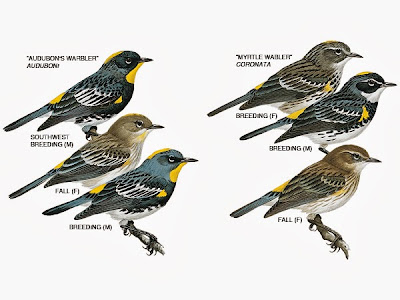Jay, in San Francisco, there’s two field marks that are excellent, diagnostic clues to help you identify both of these subspecies apart from one another (see drawings, below).
Let's sort out the "winter" plumages here only, given the obvious differences in appearance for breeding season individuals of both subspecies.
Most (but NOT all) Audubon’s adults during the "winter" wear a faint to solid yellow throat and the Myrtle always possesses a white throat. In all age classes — from hatch year to definitive adults — a Myrtle never shows a yellow throat. That’s the easy, brief answer.
(Above drawing courtesy of National Geographic.)
But it’s not the full one. That’s because rare to occasional individuals of Audubon's ALSO may express a white throat. Which means it's possible to view a white-throated Yellow-rumped Warbler that could be EITHER the Myrtle or Audubon's subspecies.
So now what do you do for ID?
Use the absence of a faint supercilum (i.e., eyebrow) to identify Audubon’s (see drawing here) during the non-breeding "winter" season. Noticing the lack of this feature on a Yellow-rumped Warbler with a white throat should move you to say: “Bingo, it’s an Audubon’s" (i.e., Audubon's are said to wear a "plain face.)
However, if you see during the non-breeding season both a faint white supercilum mark and a white throat that reaches around toward the middle and mid-back region of the neck area on both sides of the head, then it’s a Myrtle.
In sum, Myrtle Yellow-rumped Warbler shows a faint white supercilum and a greater amount of white throat surface area than the Audubon’s subspecies that has a more plain face (lacking the white supercilium mark) and a smaller white to, more typically, faint to dark yellow throat.
The definitive source for my judgment in this matter consistently remains the Identification Guide to North American Bird, Part 1, by Peter Pyle (Slate Creek Press), which is the bird bander's guide to identification of birds "in the hand," and features field mark information corresponding to all age classes of songbirds.
The definitive source for my judgment in this matter consistently remains the Identification Guide to North American Bird, Part 1, by Peter Pyle (Slate Creek Press), which is the bird bander's guide to identification of birds "in the hand," and features field mark information corresponding to all age classes of songbirds.

1 comment:
Nice info., thanks....
Post a Comment